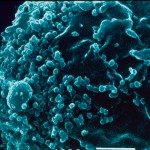Link to Pubmed [PMID] – 2124274
J. Mol. Biol. 1990 Dec;216(3):689-99
The retroviral genome consists of two identical RNA molecules joined at their 5′ ends by the Dimer Linkage Structure (DLS). To study the mechanism of dimerization and the DLS of HIV-1 RNA, large amounts of bona fide HIV-1 RNA and of mutants have been synthesized in vitro. We report that HIV-1 RNA forms dimeric molecules and that viral nucleocapsid (NC) protein NCp15 greatly activates dimerization. Deletion mutagenesis in the RNA 5′ 1333 nucleotides indicated that a small domain of 100 nucleotides, located between positions 311 to 415 from the 5′ end, is necessary and sufficient to promote HIV-1 RNA dimerization. This dimerization domain encompasses an encapsidation element located between the 5′ splice donor site and initiator AUG of gag and shows little sequence variations in different strains of HIV-1. Furthermore, cross-linking analysis of the interactions between NC and HIV-1 RNA (311 to 415) locates a major contact site in the encapsidation element of HIV-1 RNA. The genomic RNA dimer is tightly associated with nucleocapsid protein molecules in avian and murine retroviruses, and this ribonucleoprotein structure is believed to be the template for reverse transcription. Genomic RNA-protein interactions have been analyzed in human immunodeficiency virus (HIV) virions and results showed that NC protein molecules are tightly bound to the genomic RNA dimer. Since retroviral RNA dimerization and packaging appear to be under the control of the same cis element, the encapsidation sequences, and trans-acting factor, the NC protein, they are probably related events in the course of virion assembly.


